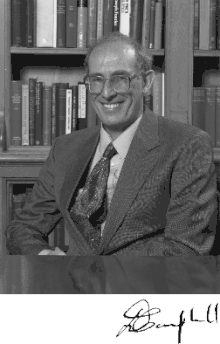Iain Campbell | |
|---|---|
 | |
| Born | Iain Donald Campbell 24 April 1941 Perth, Scotland |
| Died | 5 March 2014 (aged 72) England |
| Education | Perth Academy |
| Alma mater | University of St Andrews (BSc, PhD) |
| Known for | |
| Spouse |
Karin C. Wehle (m. 1967) |
| Awards | Croonian Lecture[2] EMBO Member |
| Scientific career | |
| Fields | |
| Institutions | University of Bradford University of Oxford |
| Thesis | An electron spin resonance study of optically excited states (1967) |
| Notable students | Annalisa Pastore (postdoc)[3] |
| Website | www |
Iain Donald Campbell FRS[4] (24 April 1941 – 5 March 2014)[1] was a Scottish biophysicist and academic. He was Professor of Structural Biology at the University of Oxford from 1992 to 2009.[5][6][7][8][9]
Early life and education
Campbell was born on 24 April 1941 in Blackford, Perth and Kinross, Scotland.[6] He was the son of Daniel Campbell and Catherine Campbell (née Lauder).[10] He was educated at Perth Academy, a state school in Perth.[6] He went on to study physics at the University of St Andrews,[7] graduating in 1963.[11] He remained at St Andrews to undertake post-graduate research and completed his Doctor of Philosophy (PhD) degree in physics.[12][7] His doctoral advisor was Dirk Bijl,[6] and he undertook research under John F. Allen.[11]
Career and research
Campbell worked briefly at the University of Bradford before moving to the Physical and Theoretical Chemistry Laboratory at the University of Oxford in South Parks Road, Oxford, in 1967, to work with the chemist Sir Rex Richards.[13] He was appointed a Fellow of St John's College, Oxford in 1987 and Emeritus Research Fellow in 2009.
Awards and honours
Campbell was elected a Fellow of the Royal Society (FRS) in 1995.[13] He was elected a member of the European Molecular Biology Organisation (EMBO). He was awarded the Croonian Lecture by the Royal Society in 2006[2] and received honorary degrees from the University of Lund, University of Portsmouth and University of St Andrews.
Personal life
Campbell married Karin Wehle in 1967.[13] They had two daughters and a son.[1] The family lived in Summertown, Oxford. Campbell died of bone cancer.
References
- 1 2 3 Anon (2017). "Campbell, Prof. Iain (Donald)". Who's Who & Who Was Who (online Oxford University Press ed.). Oxford: A & C Black. doi:10.1093/ww/9780199540884.013.U10024. (Subscription or UK public library membership required.)
- 1 2 Campbell, Iain D. (2008). "The Croonian lecture 2006 Structure of the living cell". Philosophical Transactions of the Royal Society B: Biological Sciences. 363 (1502): 2379–91. doi:10.1098/rstb.2006.1960. PMC 1955230. PMID 17255009.
- ↑ "PeerJ - Profile - Annalisa Pastore". Peerj.com. Retrieved 6 November 2018.
- ↑ Naismith, James H. (2021). "Iain Donald Campbell. 24 April 1941—5 March 2014". Biographical Memoirs of Fellows of the Royal Society. 71: 59–77. doi:10.1098/rsbm.2021.0003. S2CID 234771892.
- ↑ "Professor Iain Campbell Page - Department of Biochemistry, University of Oxford". Bioch.ox.ac.uk. Retrieved 7 November 2018.
- 1 2 3 4 "Professor Iain Campbell – obituary". The Daily Telegraph. 14 April 2014. Retrieved 17 May 2014.
- 1 2 3 "Professor Iain Campbell". The Times. 13 May 2014. Retrieved 17 May 2014.
- ↑ Sansom, Mark S.P. (2014). "Iain Campbell — a personal recollection". Structure. 22 (4): 507–8. doi:10.1016/j.str.2014.03.009. PMID 24918233.
- ↑ Redfield, Christina (2014). "Iain D Campbell 1941-2014". Nature Structural & Molecular Biology. 21 (5): 427–8. doi:10.1038/nsmb.2821. PMID 24799035.
- ↑ "Prof Iain Campbell: A pioneer of essential scientific techniques". Oxford Mail. 20 March 2014. Retrieved 17 May 2014.
- 1 2 "Iain Campbell". heraldscotland.com. The Herald. 14 March 2014. Retrieved 18 May 2014.
- ↑ Campbell, Iain Donald (1967). An electron spin resonance study of optically excited states. st-andrews.ac.uk (PhD thesis). University of St. Andrews. OCLC 628221103. Copac 376612.
- 1 2 3 "Professor Iain Campbell: Fellow of St John's College and distinguished scientist". The Oxford Times. 20 March 2014. p. 45.